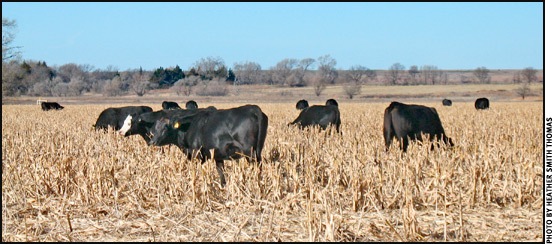
Alternative Feeds
Producers have several options when looking for protein to supplement poor-quality forage.
On dry years, or whenever hay is expensive, alternative feeds can help stretch or replace traditional forages. Feasibility of alternatives will depend on your location and how much freight is involved.
Poor-quality forages can be supplemented with many protein sources, says Craig Iwanski, veterinarian and owner of Central Veterinary Services, Stockton, Kan.
"In our part of the country some producers use wet distillers' grain, which can be fed at 10 pounds (lb.) a day to get the necessary pound of protein," he says. "It's also a good energy source. Producers just need to be careful how much they feed. If it's more than 40% of the total dry matter in the ration, you have to watch sulfur content."
Many people use liquid protein supplements, but these aren't as cost-effective as some other types, Iwanski says. "You may be paying $90 for a 200-pound tub that's only 30% protein. That ends up being about $1.50 per pound of protein, whereas alfalfa hay at $200 per ton computes to about 55¢ per pound. Alfalfa is still the best protein supplement because you also get vitamin A, a little energy and some roughage."
Soybean meal is another good source of protein, and so are field peas.
"Peas are 25% protein and can also be part of the energy content. You shouldn't feed more than 40% peas in the dry-matter total, but it's highly rumen degradable — a high-bypass protein with a positive influence on forage digestion and gain efficiency."
A study done in North Dakota showed that, for cows, you don't need to process the peas. "You can feed them whole and cows do fine," says Iwanski.
"In the Dakotas, farmers have increased their acreage of field peas as a cover crop that can be harvested for cattle. Price-wise this was the cheapest source of protein I could find this year — about 36¢ per pound of protein," he says.
"In this area, it's sometimes feasible to graze wheat, or use triticale or turnips. Anything the cows can harvest themselves will save money. They are the most efficient harvesters we have, if we can let them graze."
Some people still graze soybean stubble, but it must be supplemented with energy and protein — since soybean stalks have a high percent of indigestible roughage. "We used to graze milo stalks, but today it's harder to find crop aftermath grazing, with the no-till practices. A lot of farmers in our area don't like cattle on the fields because they're worried about soil compaction. But we have enough freeze-thaw cycles here to help reverse the compaction," says Iwanski.
[Click here to go to the top of the page.]










